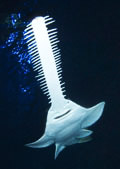'Oceanic Odyssey'
Diving with Oceanic Whitetip Sharks at Cat Island
in the Bahamas
First published in
Diver Magazine November 2011
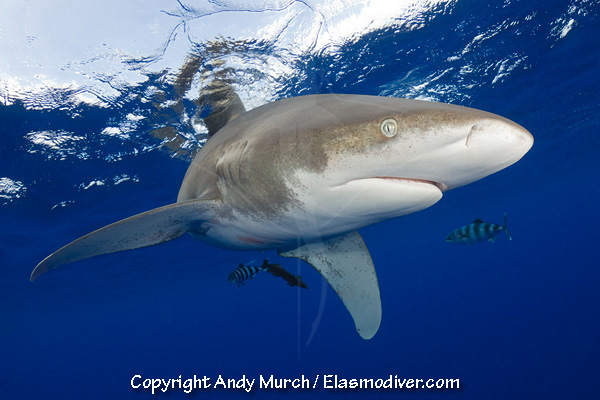
Teetering on the very edge of the continental shelf, it is
not surprising that Cat Island attracts mega fauna seldom seen elsewhere in
the Caribbean.
From monster marlin to massive mahi, Cat Island is an important pit stop for
apex predators plying the western Atlantic in search of a meal.
Although Cat was discovered generations ago by sport fishermen looking for
record breaking animals, tales of hooked billfish being mobbed by hungry
sharks only recently came to the attention of the international diving
community.
Once the word was out, divers began dropping into three thousand feet of
clear blue offshore water to swim with one of the ocean’s most notorious
inhabitants: Carcharhinus longimanus, more commonly known as the
oceanic whitetip shark.
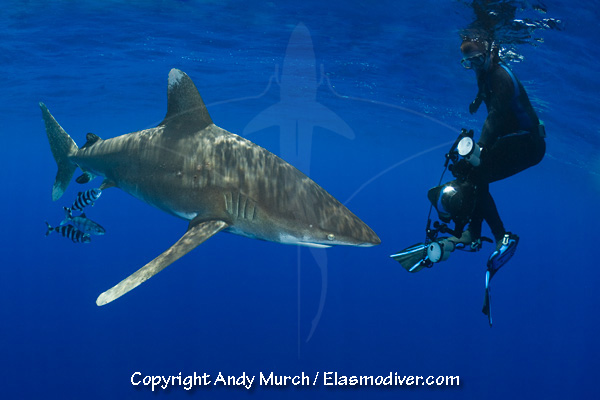
Intrigued by the prospect of an encounter with a shark that few divers have
seen this side of Africa, I hopped on a puddle jumper from Nassau and
boarded Epic Diving’s Atlantic Explorer.
Barely ten minutes after leaving the marina, the sea floor fell away into
the abyss, which was our cue to start chumming for oceanics. Accustomed to
the slow process of attracting pelagic sharks, I was surprised to watch the
Captain revving the engines and throwing the converted sport fisher into
tight turns and circles.
He explained that the sharks are instantly attracted to the jerky sounds of
the engines because they mimic a sport fishing boat that is fighting a game
fish.
Revving the engines is particularly effective because it attracts sharks
from every direction whereas a chum slick by itself produces a linear scent
trail that the sharks must stumble across before they become interested.
The Captain’s aural ruse was immediately successful. The first frosted
dorsal fin materialized like a snow capped peak slicing magically through
the water.
I slipped in with snorkel and fins. The oceanic swam boldly towards me and
we spent a brief moment appraising each other.
I was in the presence of a two meter female. Her coloration was like no
shark I had ever seen and I was utterly captivated by her golden hide that
gave way to a layer of subtle stippling on her lower flanks and then faded
seamlessly into the creamy counter-shading of her belly.
Her broad, ivory tipped pectoral fins and powerful heterocercal tail
appeared perfectly adapted to provide effortless lift and maneuverability on
long ocean voyages. Like a glider riding thermals, she could face into the
current and hold position or be swept downstream with virtually no energy
expenditure.
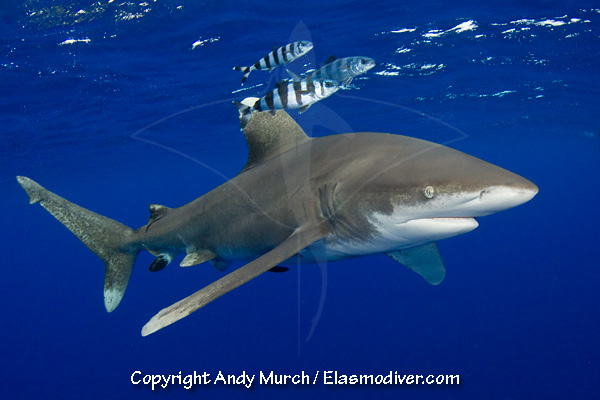
Her catlike pupil and freckled iris flicked back and forth uncertainly in my
direction but her body language betrayed no signs of malice. Before long,
she returned to her slow exploration of the bait crates but came back to
visit me regularly.
Over the next six hours, more oceanics made their way up the irresistible
chum trail. All were mature females and I was reassured to see that some
were close to term.
One large individual was flanked by an entourage of vertically striped pilot
fish that would dart away to pluck scraps from the water column before
returning to the safety of ‘the mother ship’.
At one point, a confused pilot fish fell into step beside the wrong shark,
then did a comical about-face and swam at lightning speed back to its
original host. One can only assume that certain sharks have developed a
taste for pilot fish.
No sharks showed any aggression towards me or the other divers that had
joined me at the back of the boat, but when a 4ft mahi mahi (Coryphaena
hippurus) entered the fray, the sharks became visibly agitated. It was clear
that the erratic movements of a natural prey species triggered a strong
hunting response that the presence of humans and even the bloody chum slick
did not.
At the marina the next morning, I bumped into Ed Brooks from the University
of Cape Eluethra. Ed was finishing up a scientific expedition that had
placed tags on eleven whitetip sharks.
He explained that virtually nothing is known about the migratory patterns of
western Atlantic oceanics other than the fact that they arrive off Cat
Island in early April and are gone by the end of June. He hopes that when
the satellite tags pop to the surface later this year, he will be able to
trace their progress and perhaps even figure out what they are following.
Ed is also working on a photographic database of individual oceanic whitetip
sharks that he hopes divers will embrace and contribute to. The database
employs the same stellar mapping software that is used to identify and track
whale sharks on their global migrations.
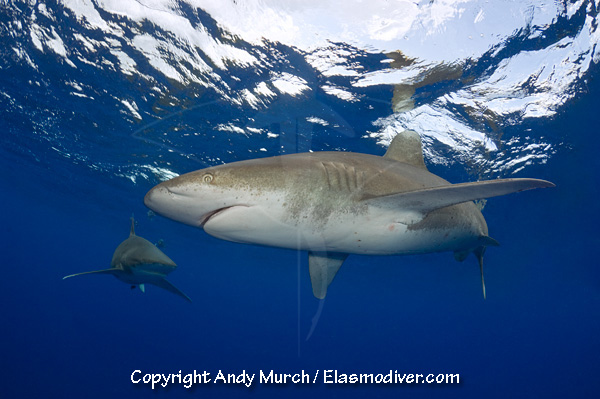
Listed by the IUCN as critically endangered in the western Atlantic, the
oceanic whitetip shark has become the unfortunate poster child of shark
conservation movements.
A 2005 paper on the decline of pelagic shark populations in the Northwest
Atlantic by Dr Julia Baum and the late Ransom Myers, states that
C.longimanus stocks in the Gulf of Mexico have been reduced by a staggering
99% with silky sharks not far behind.
For decades, oceanics have been taken for their meet, skin and oil but it is
their long spatulate fins that make them such a desirable catch.
Convincing fishermen to leave the sharks alone is a tough sell when the fins
fetch upwards of $85 per kilo on the international market.

Its an uphill battle that is hindered by the sharks’ fearsome reputation.
Dubbed the wolves of the ocean, whitetips have a history of capitalizing on
the misfortune of shipwrecked sailors and downed airmen.
An unforgettable example of their opportunistic behavior occurred in the
summer of 1945 when the USS Indianapolis (on its way home from delivering
parts for the atomic bomb that was later dropped on Hiroshima) was torpedoed
by a Japanese submarine.
Nearly 900 hapless sailors leapt clear of their doomed vessel only to face
four harrowing days immersed in the Pacific awaiting rescue. During their
ordeal, the men fell victim to exposure, dehydration and shark attacks.
Oceanics were implicated as the most likely culprits but it is unclear how
many of the 560 men that perished in the water were actually taken by the
gathering mass of sharks.
Our next day with the oceanics was as fin-filled as the first. Following the
recommendations of a local sport fisherman (who was more than happy for us
to keep the shark population busy) we headed to an area off the exposed east
side of the island and started ‘pulling doughnuts’ with the boat while a
greasy finger of fish oil snaked away down current.
When a whitetip shark appeared in record time we named the new site ‘Oceanic
Express’.
Five hours later, I had images from so many angles that I decided to switch
off my strobes and just hang on the tag line until it was time to leave.
Oceanic Express turned out to be our most productive site of the trip with
multiple sharks ready to play and fly-bys of marlin, mahi and even a baby
tiger shark.
In spite of their reputation, the oceanics were on their best behavior
through every encounter and I was left with the conviction that until we
start putting protection before profit, we will remain far more of a threat
to the sharks than they are to us.
Andy Murch is a Photojournalist and
outspoken conservationist specializing in images of sharks and rays.
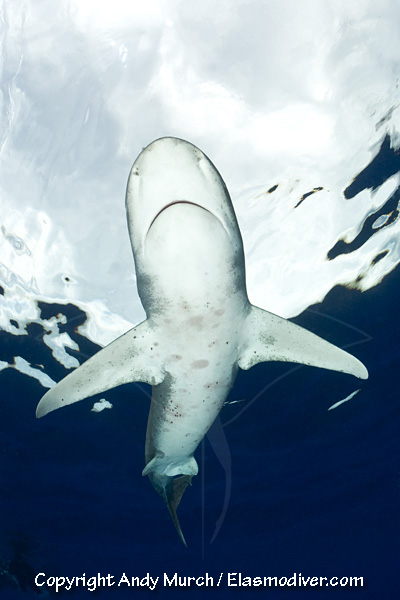
About Cat Island:
Although Cat is the tallest of The Bahamas 600+ islands, at 206ft you should
leave your skis at home.
Much of the coastline is covered in mangrove but there are many quiet
beaches, all of which have healthy fringing reefs.
Far from the maddening crowds, Cat Island has a handful of small resorts
including Hawksnest (hawks-nest.com) which also boasts the island’s only
marina.
Getting there and away:
Cat Island’s New Bight Airport (TBI) is serviced twice daily by Sky Bahamas
from Nassau (NAS) and less frequently by Continental and Lynx Air from Fort
Lauderdale.
Shark Encounters and Reef Diving:
http://bigfishexpeditions.com/OceanicWhitetipSharkExpedition.html
|
